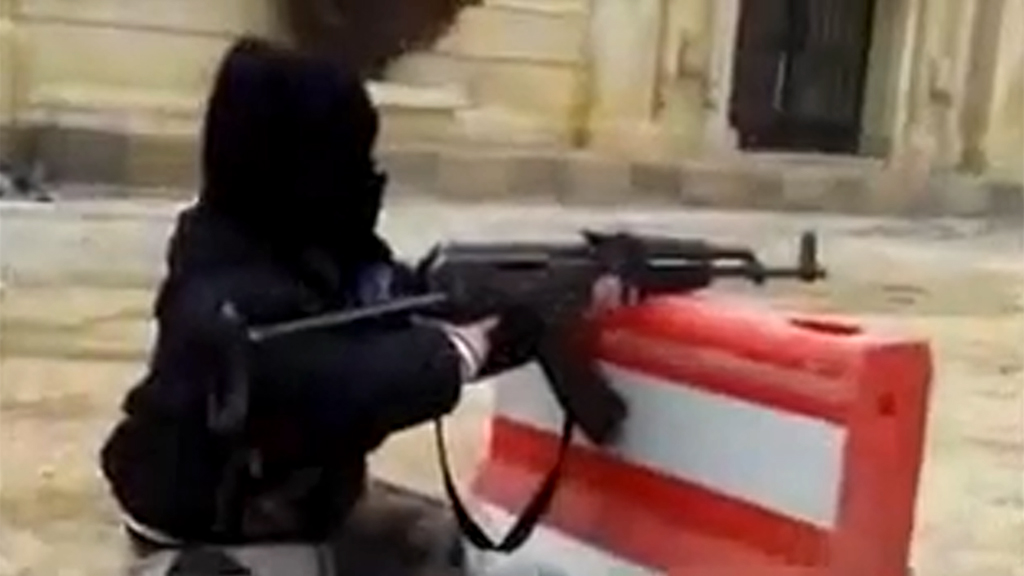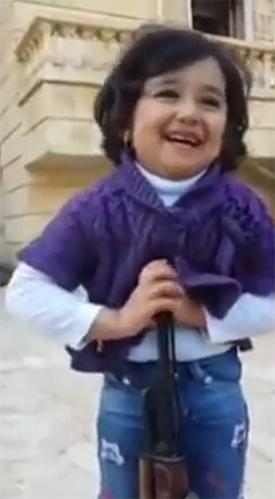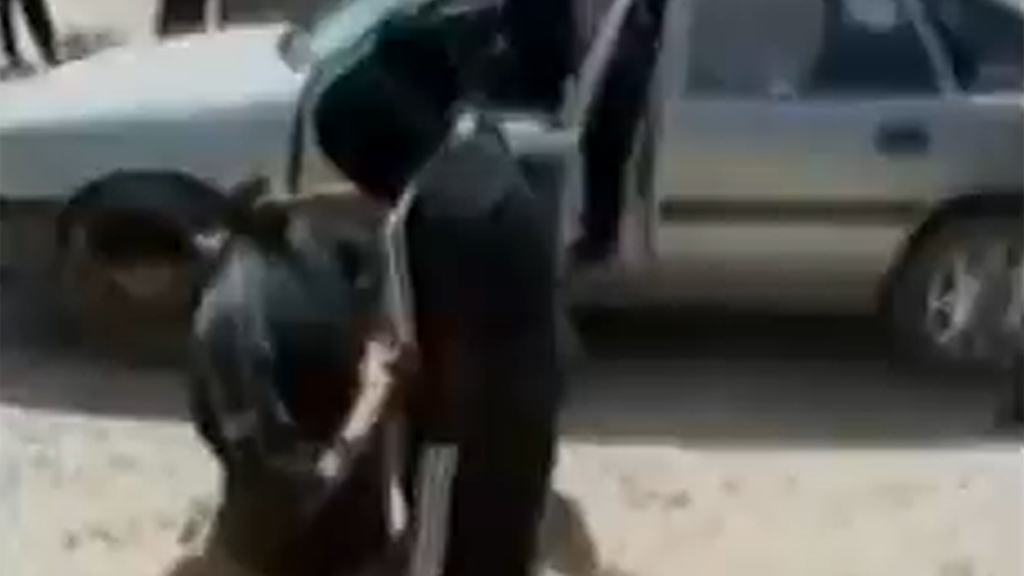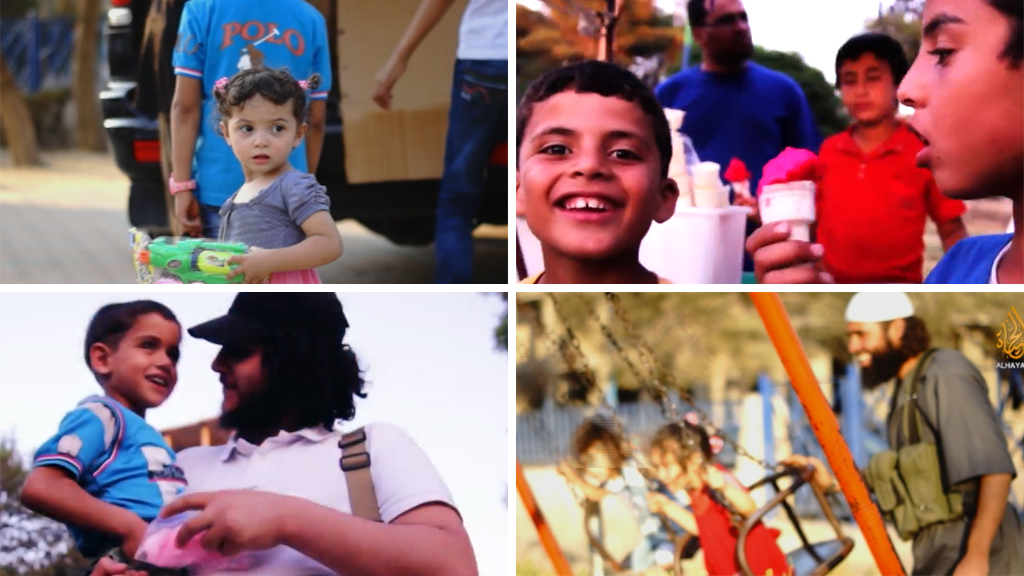Guns and toys: the children of the Islamic State
Holding up severed heads, carrying guns and declaring that non-believers will be “butchered” – Channel 4 News examines what life is like for children in the Islamic State.
On Sunday pictures emerged of a seven-year-old boy, said to be the son of an Australian Islamic State fighter, holding the severed head of a soldier in Raqqa, Syria (above, centre).
The shocking picture appears to come from the end of July, and other photos posted on social media show other children and adults holding heads – the bodies were hung on a nearby fence. Islamic State accounts claim the men are Shia soldiers with the army of Bashar al-Assad.
The image, said to have been tweeted along with the words “That’s my boy”, is the latest to emerge from the Islamic State’s self-declared caliphate showing children.
‘Utopia’
Messages coming from the Islamic State about children are mixed, and Channel 4 News has unearthed a range of Islamic State videos – showing children being given toys and ice cream to children being trained to kill.
Kuffar? I tell them they are going to be butchered. Three-year-old boy
On the one hand the militant group is keen for Sunni Muslims across the world to think of the caliphate as a safe and fun place for children – so that they will move there.
On the other, videos also exist of children being trained with assault weapons and in hand-to-hand combat. Or of children declaring their hatred for America and vowing jihad.
These two conditions for children are not mutually exclusive in the eyes of Islamic State, argues Raffaello Pantucci, a Middle East expert at the Royal United Services Institute.
They are not quite understanding, their minds are being warped. Raffaello Pantucci
“These identities are one and the same,” he told Channel 4 News. “The vision is of a perfect utopian state.
“This group of guys who carved out the state are there with woman and children. That is what they are about.”
He said examples of this fusion of ideas can also be seen in videos by Uzbek and Uighur militant groups in Waziristan.
When I grow up…
In one video of a three-year-old boy, posted to social media sites in January 2014, loyalty to Islamic State is evident. At the start of the video he is seen firing a rifle (pictured, below).

The child, who looks awkwardly off camera and chews on his finger, is asked what his name is. “Abu Bakr al-Baghdadi” he responds – a reference to the Islamic State leader, presumably his idol.
“Are you al Nusra, FSA or (Islamic) State?”, the man off camera asks – referring to groups of rebels in Syria. “State”, the boy responds, as he looks at his feet.
“What would you say to Muslims?” he is asked. “I want to tell Muslims to fight”, he responds.
And finally, “what would you say to kuffar (non-believers)?”
“Kuffar? I tell them they are going to be butchered.”
The video is one of many that might shock global audiences. In another, a young girl awkwardly supports herself on an automatic weapon (pictured, right) as she is asked who her emir is “Baghdadi”, she replies with a grin.

In another, a boy of around eight says what he wants to be when he grows up – a mujahid.
‘Cubs of the caliphate’
These videos, posted at the start of the year, mark a mid-point in the evolution of Islamic State videos about children.
When the group first ventured into Syria in 2013, its videos of children were more terrifying. Children, mostly teenagers, were seen training with weapons, practising raiding houses and pulling people out of cars – handguns held to their heads (pictured, below).
Children carrying the Islamic State marched through Syria. The young children were known as the “Cubs of the Khalifa (Caliphate)”. A child says he will emulate the men who turned America’s “two towers to dust”.
However, the strategy began to evolve at the start of 2014, with more videos emerging of children showing their religious knowledge, being taught how to remember the Koran, singing Islamic State songs and taking part in community events.

Now that Islamic State has established the caliphate, the message is very different. Islamic State has tightly controlled videos coming out of the caliphate, and unauthorised filming can be punished with death.

In videos like the Mujatweets series (pictured, above), produced by the Al Hayat Media Centre, show children being given toys and sweets and playing on swings.
The message is that these children are “being brought up in the correct way,” says Mr Pantucci. “They are having classes helping their mothers establish households.”
However, the guns have not gone. In one of the latest videos released children are seen holding guns – both toys and real weapons (video, below).
Islamic fighters from across the world – another method Islamic State uses to recruit people to the caliphate – pose with their children.
In the video, filmed on Eid, Abu Abdurrahman al-Trinadi, from the United States, holds his daughter in his arms. Across her back is an assault weapon.
“Look at all the little children, they are having fun,” he says to the camera as he urges people to come “as soon as you can”.
“Children are already being brutalised,” say Mr Pantucci. “They are not quite understanding, their minds are being warped.
“It is a negative thing that we are seeing a conflict that is brutalising the next generation.”
Research by Kamal Kaddourah and David Doyle